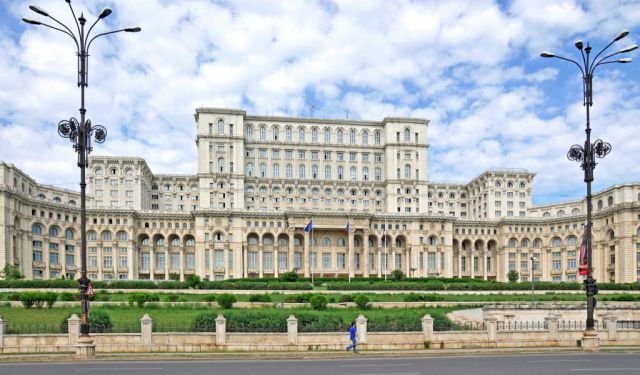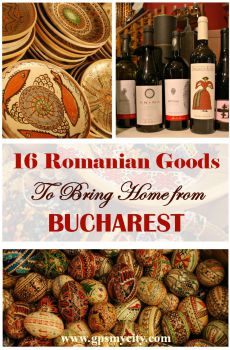
New Saint Spyridon Church, Bucharest
The New Saint Spyridon Church is a Romanian Orthodox church in Bucharest, located at 29 Calea Şerban Vodă. Originally built with considerable Gothic influence, the building (especially the towers) was strongly modified later on by Patriarch Justinian.
In 1768, another church was built on the site. It was erected for Scarlat Ghica by his son, Alexandru Ghica. Eventually, the church was seriously damaged by a number of earthquakes and fires and was subjected to reconstruction.
The present church was built in 1852-1858 and painted in oil. Particularly notable is the altar screen, the work of painter Gh.Tattarescu.
In 1885, a strong wind destroyed some parts of the main façade which was immediately restored without sticking much to the original. In 1954, after a serious earthquake, full repairs had to be performed. On that occasion, two side balconies were added inside the church plus another one beneath the existing balcony designed for chorus. After 1966, the towers and arches were strengthened and the initial oak foundation was replaced with that of reinforced concrete.
The huge construction has retained its original neo-Gothic style. The form of the church is rectangular, consisting of a single nave preceded by a small vestibule which ends with the polygonal apse of the altar to the East. The entrance represents a small porch situated between the side towers with a central arch and two lateral narrow bays, supported by columns. Inside, the aisle is covered with a barrel vault system, arches and pendants, over which, in the centre of the nave, rises the main tower. Large windows are decorated with stained glass made in Vienna.
The Saint Spyridon the New Church (Romanian: Sfântul Spiridon Nou) is a Romanian Orthodox church in Bucharest, Romania on Calea Şerban Vodă, no. 29. Originally built with gothic influences, it was strongly modified by Patriarch Justinian (especially the towers).
In 1768, another church was built on the site. It was erected for Scarlat Ghica by his son, Alexandru Ghica. Eventually, the church was seriously damaged by a number of earthquakes and fires and was subjected to reconstruction.
The present church was built in 1852-1858 and painted in oil. Particularly notable is the altar screen, the work of painter Gh.Tattarescu.
In 1885, a strong wind destroyed some parts of the main façade which was immediately restored without sticking much to the original. In 1954, after a serious earthquake, full repairs had to be performed. On that occasion, two side balconies were added inside the church plus another one beneath the existing balcony designed for chorus. After 1966, the towers and arches were strengthened and the initial oak foundation was replaced with that of reinforced concrete.
The huge construction has retained its original neo-Gothic style. The form of the church is rectangular, consisting of a single nave preceded by a small vestibule which ends with the polygonal apse of the altar to the East. The entrance represents a small porch situated between the side towers with a central arch and two lateral narrow bays, supported by columns. Inside, the aisle is covered with a barrel vault system, arches and pendants, over which, in the centre of the nave, rises the main tower. Large windows are decorated with stained glass made in Vienna.
The Saint Spyridon the New Church (Romanian: Sfântul Spiridon Nou) is a Romanian Orthodox church in Bucharest, Romania on Calea Şerban Vodă, no. 29. Originally built with gothic influences, it was strongly modified by Patriarch Justinian (especially the towers).
Sight description based on Wikipedia.
Want to visit this sight? Check out these Self-Guided Walking Tours in Bucharest. Alternatively, you can download the mobile app "GPSmyCity: Walks in 1K+ Cities" from Apple App Store or Google Play Store. The app turns your mobile device to a personal tour guide and it works offline, so no data plan is needed when traveling abroad.
New Saint Spyridon Church on Map












Sight Name: New Saint Spyridon Church
Sight Location: Bucharest, Romania (See walking tours in Bucharest)
Sight Type: Religious
Sight Location: Bucharest, Romania (See walking tours in Bucharest)
Sight Type: Religious
Walking Tours in Bucharest, Romania
Create Your Own Walk in Bucharest
Creating your own self-guided walk in Bucharest is easy and fun. Choose the city attractions that you want to see and a walk route map will be created just for you. You can even set your hotel as the start point of the walk.
Old Town Walking Tour
The Historical Center of Bucharest, or the Old Town, as the locals habitually refer to it, is one of the most beloved and attractive areas in the Romanian capital. The neighborhood is really beautiful a place to visit, and you can walk into it pretty much from anywhere in central Bucharest. Ion Constantin Brătianu Boulevard crosses the historic heart of the city from Piata Universitate... view more
Tour Duration: 2 Hour(s)
Travel Distance: 1.9 Km or 1.2 Miles
Tour Duration: 2 Hour(s)
Travel Distance: 1.9 Km or 1.2 Miles
Bucharest Introduction Walking Tour
Bucharest, the capital and cultural center of Romania, is one of the largest cities in Southeastern Europe.
The name București has an unverified origin. Tradition links it to the guy named Bucur, who (according to various legends) was either a prince, outlaw, fisherman, shepherd or a hunter. The Romanian word “bucurie” means joy (happiness), which in turn explains one of Bucharest's... view more
Tour Duration: 2 Hour(s)
Travel Distance: 3.7 Km or 2.3 Miles
The name București has an unverified origin. Tradition links it to the guy named Bucur, who (according to various legends) was either a prince, outlaw, fisherman, shepherd or a hunter. The Romanian word “bucurie” means joy (happiness), which in turn explains one of Bucharest's... view more
Tour Duration: 2 Hour(s)
Travel Distance: 3.7 Km or 2.3 Miles
Useful Travel Guides for Planning Your Trip
16 Uniquely Romanian Things To Buy in Bucharest
Nicknamed "Little Paris", today's Bucharest is the capital of a vibrant European nation, known as Romania, with lots of history and great cultural heritage - spanning from centuries-old rural traditions to New Wave cinema. Keen on rustic stuff, Romanians carefully preserve their...



